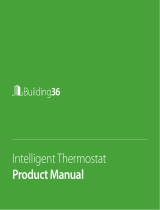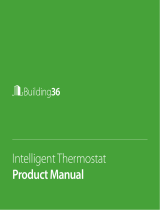Aprilaire 8570 is an advanced programmable thermostat that provides precise temperature control and monitoring for your home's heating and cooling systems. It allows for customization of temperature settings, energy-saving features, and remote access for added convenience. With its user-friendly interface, you can easily program the thermostat to maintain desired temperatures throughout the day, optimizing comfort and reducing energy consumption.
Aprilaire 8570 is an advanced programmable thermostat that provides precise temperature control and monitoring for your home's heating and cooling systems. It allows for customization of temperature settings, energy-saving features, and remote access for added convenience. With its user-friendly interface, you can easily program the thermostat to maintain desired temperatures throughout the day, optimizing comfort and reducing energy consumption.




















-
 1
1
-
 2
2
-
 3
3
-
 4
4
-
 5
5
-
 6
6
-
 7
7
-
 8
8
-
 9
9
-
 10
10
-
 11
11
-
 12
12
-
 13
13
-
 14
14
-
 15
15
-
 16
16
-
 17
17
-
 18
18
-
 19
19
-
 20
20
-
 21
21
-
 22
22
-
 23
23
-
 24
24
-
 25
25
-
 26
26
-
 27
27
-
 28
28
-
 29
29
-
 30
30
-
 31
31
-
 32
32
-
 33
33
-
 34
34
-
 35
35
-
 36
36
-
 37
37
-
 38
38
-
 39
39
-
 40
40
Aprilaire 8570 is an advanced programmable thermostat that provides precise temperature control and monitoring for your home's heating and cooling systems. It allows for customization of temperature settings, energy-saving features, and remote access for added convenience. With its user-friendly interface, you can easily program the thermostat to maintain desired temperatures throughout the day, optimizing comfort and reducing energy consumption.
Ask a question and I''ll find the answer in the document
Finding information in a document is now easier with AI
Related papers
-
Aprilaire 400 User manual
-
Aprilaire 60 Safety And Installation Instructions Manual
-
Aprilaire 60 Safety And Installation Instructions Manual
-
Aprilaire 60 Owner's manual
-
Aprilaire Dehumidifier 65 User manual
-
Aprilaire Dehumidifier 65 User manual
-
Aprilaire 8870 Owner's manual
-
Aprilaire 60 Safety And Installation Instructions Manual
-
Aprilaire 8570 Owner's manual
-
Aprilaire 8052 Installation Instructions And Use
Other documents
-
Trane CONTH01AAUTOA Installer's Manual
-
Trane ECONTH01AAUTOA Installation guide
-
Building 36 B36-T10 User manual
-
 Building 36 Intelligent Thermostat User manual
Building 36 Intelligent Thermostat User manual
-
 Building 36 Intelligent Thermostat User manual
Building 36 Intelligent Thermostat User manual
-
Lennox International Inc. icomfort Wi-Fi User manual
-
Lennox icomfort Wi-Fi Installer's System Setup Manual
-
Lux Products KONOz Owner's manual
-
Venstar T1010 Installation guide
-
Lennox icomfortTouch User manual









































